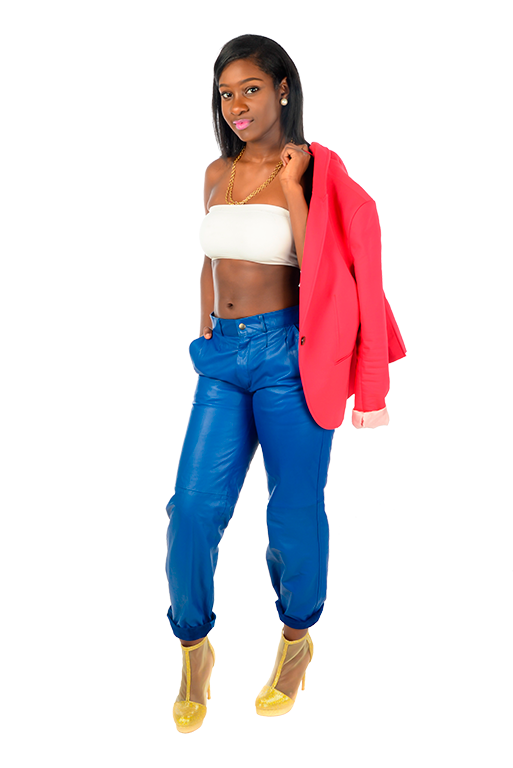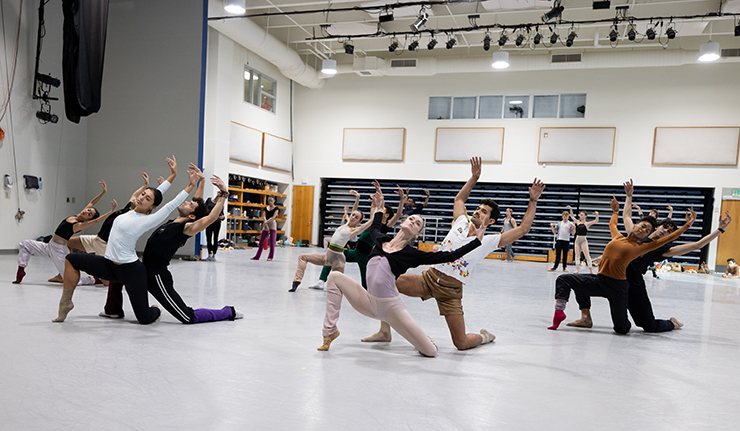
Miami City Ballet Dancers rehearsing "Analogo" by Margarita Armas opening this weekend in West Palm Beach at the Kravis Center and starting Feb. 9 at the Arsht Center in Miami. (Photo by Alexander Iziliaev)
Miami City Ballet begins its winter run with a program that provides a story ballet, a new contemporary work, a new classical work and a dynamic revival. It is a mix of repertory that will not fail to entertain and excite even the most stalwart dance critics. Opening at West Palm Beach’s Kravis Center on Saturday, Feb. 3 continuing with performances at the Arsht Center in Miami and the Broward Center in Fort Lauderdale, the program, “Winter Mix” is indeed a showcase for the versatile MCB dancers.
Five dance artists from MCB gave their time during a busy rehearsal day to speak about the program and the choreographers. “Winter Mix” contains three rather large ballets, “Análogo,” “PAGANINI, In Play” and “Concerto DSCH” as well as the lavish fairy tale ballet, “Firebird.” The full 48 member company is used in this program.
“Análogo” is a ballet created by up and coming choreographer, Margarita Armas, with music by the musical group, Aukai, instrumental sounds from Miss Meadow, and a closing song by Nina Simone.
Armas created her first solo on MCB, “Geta” inspired by former MCB instructor, Geta Constantinescu with whom Armas had studied. “Análogo” will be her first world premiere for MCB.
"Análogo" means similar or analogous. To that end, Armas has created a contemporary style piece that delves into partnerships as experienced in different aspects of life; flora, fauna, and in humans.
MCB dancer, Mayumi Enokibara, grew up working side by side with Armas as a student at MCBS. Joining the company in 2015, Enokibara is working with Armas, for the first time, as a choreographer.
“Her movement is very modern,” says Enokibara. “We’re in socks. It’s different than we normally do. We worked with her for the first few days just learning her movement, what she’s envisioning for this new work.”
There are 12 dancers in the cast with two complete casts.
“It’s about connection. Lots of dancing together, looking at each other. There are three sections and each one has a different quality.”
According to Enokibara, the dancers would come to “Análogo” rehearsals wearing sweatpants and baggy clothes to get more into the feel of Armas’s grounded movement. They were surprised to find the the costumes are slick and revealing, hand painted, unitards.
“They’re really beautiful,” says Enokibara. “Very dark with lots of patterns. You can really see the movement and I think that’s what Margarita wanted. It’s a beautiful ‘feel good’ collage.”
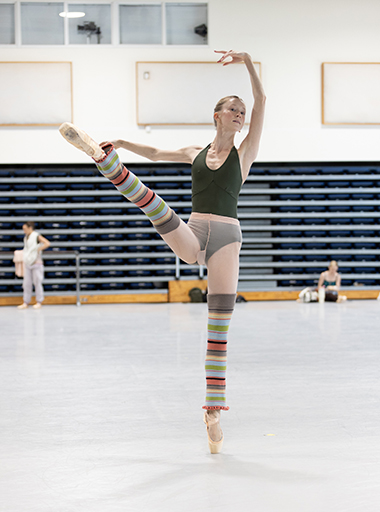
Mary Kate Edwards rehearsing "PAGANINI, In Play," the world premiere choreographed by Durante Verzola. (Photo by Alexander Iziliaev)
Mary Kate Edwards and Damian Zamorano are working together in Durante Verzola’s world premiere work, “PAGANINI, In Play.” Verzola was a a student in the MCBS and presently serves as Miami City Ballet School instructor and resident choreographer. This is his third world premiere for MCB.
At the time of this conversation, Edwards had just returned from performing excerpts from ‘Paganini’ as part of New York’s Guggenheim Works & Process series, “Durante Verzola, A Choreographic Portrait.” The New York conversation gave her more insight into the thoughts of Verzola for this new piece.
Similar to Armas, both dancers had either studied with Verzola at MCBS or worked with him as a new choreographer. They had partnered together in Verzola’s last piece for MCB, “Sentimiento” and were familiar with his crisp, classical movement.
“I think at MCB, we tend to dance really fast,” says Zamorano. “And his style is very fast. You can tell he is inspired by Balanchine and the movement is very challenging. There are four movements and we do the pas de deux (dance for two) in the first movement. It is very quick allegro movement.”
As it is called “PAGANINI, In Play,” Edwards explains ‘in play.’
“He wanted us to play with the music — to see how far we could stretch the notes, to play with the movement. I feel like our pas de deux is not romantic (though the third movement is). It starts with just me and four men on stage, I feel very powerful,” she says.
Edwards is demonstrating the movement as she speaks. Her hands, head and eyes are very animated as she moves her arms and wiggles her fingers to demonstrate the space.
“Durante knows each of us quite well and I think he choreographs to push each person to be better, to do more,” says Zamorano.
Inspired by the music, in Verzola’s work, it is a marriage of musicality, what he can bring out in the dancers and what he wants to show in his creation.
The couple were explaining the difference between Alexei Ratmansky’s “Concerto DSCH” also a balletic piece on the program, in which they both dance.
Zamorano says, “The movement in DSCH is very big, the arms, sometimes legs turned in, turned out, still with great energy and very expressive.”
Visually, “PAGANINI, In Play” has more streamlined, and purely elegant classical lines, while DSCH, also classical, has a more robust energy, lots of personality, and is playful.
It is interesting to hear what dancers themselves find different about the various pieces that they dance, other than the obvious.
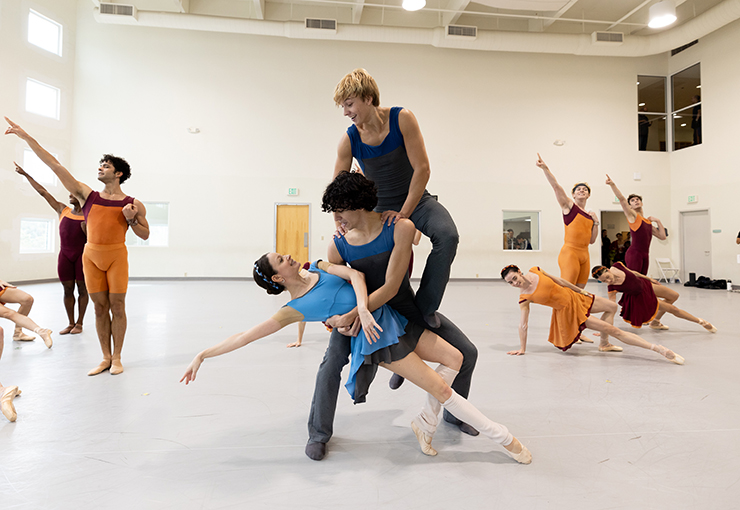
Jennifer Lauren, Francisco Schilereff, and Brooks Landegger in Alexei Ratmansky's "Concerto DSCH." (Photo by Alexander Iziliaev)
Two dancers speaking about Alexei Ratmansky’s 2008 “Concerto DSCH” are MCB principal, Dawn Atkins who dances the pas de deux, and Brooks Landegger dancing the trio, joining MCB respectively in 2021 and 2022.
While MCB did "DSCH" in 2018, this is the first Ratmansky piece they both are dancing.
"DSCH" was set by former New York City Ballet principal, Amar Ramasar, who had performed the piece in New York when it was first choreographed.
“Amar has such a positive approach to the ballets that we’ve done with him. He’s so diligent and clear and really does his homework. He also tries to relay as much of the history of the piece to us as he can gather,” says Atkins.
Landegger concurs. “He worked directly with Alexei and was there from the beginning. He tells us how Alexei would want certain steps, how they were created. He was an extraordinary dancer - one of the best of our time.”
Both Atkins and Landegger agree that Ramasar’s rehearsals have been much fun. The Ratmansky choreography and style is challenging, the steps are difficult, but there is a great sense of fulfillment ,as Atkins says, ‘because it’s so challenging.’
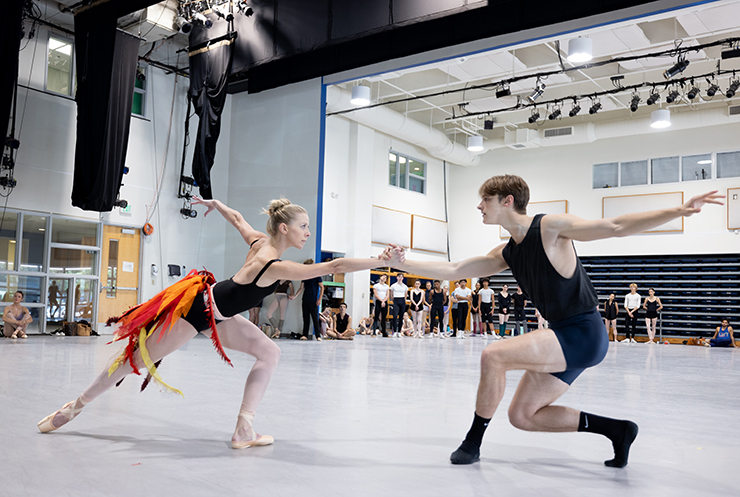
Dawn Atkins and Cameron Catazaro rehearse "Firebird" at the Miami City Ballet studios. Choreography by Jerome Robbins and George Balanchine. (Photo by Alexander Iziliaev)
“DSCH” is a ballet of relationships.
Atkins says, “It is stories of young love, so each couple interprets it a little differently. There is a moment when my partner is dancing with another woman and I come on stage with my hand on my hip in a little interaction. My character is more mature, and she is lively and youthful. But it’s all very playful.”
“The Shostakovich music is so exciting,” continues Atkins. “It’s such physical dancing and the music paired with it, it’s just thrilling.”
For the title, the initials DSCH refer to the initials of Dimitri Schostakowitsch in German translation. DSCH is a musical motif often used by the composer Dmitri Shostakovich to represent himself.
Opening the program is George Balanchine’s 1949, “Firebird” to a musical score by Igor Stravinsky. With a new production created by Anya Klepikov and lighting by James F. Ingalls for the MCB 2019-2020 season, this battle between good versus evil is a suspenseful fairy tale that captivates audiences. The MCB production is the only Balanchine “Firebird” performed outside of New York City Ballet.
Principal artists, Nathalia Arja and Chase Swatosh are well known as the sultry Firebird and stalwart Prince Ivan . This season additions will be Atkins performing the Firebird with Cameron Catazaro as Prince Ivan and Taylor Naturkas performing with Landegger.
Atkins, a taller dancer, has found learning the role fulfilling and challenging. A role usually given to a smaller dancer, she has needed to find ways to make the technique and style fit to her lengthy body type and way of moving.
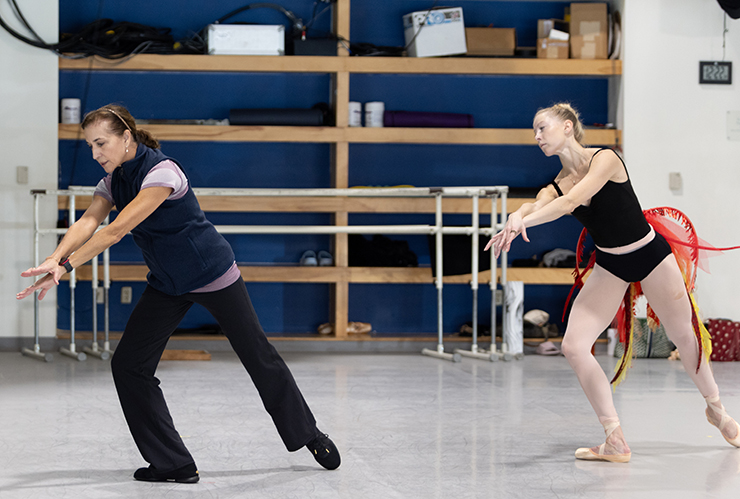
Miami City Ballet Artistic Director Lourdes Lopez coaches Dawn Atkins in "Firebird." Choreography by Jerome Robbins and George Balanchine (Photo by Alexander Iziliaev)
As a former principal artist with NYCB, audiences clamored to see now MCB Artistic Director, Lourdes Lopez, performing Balanchine’s “Firebird.”
Lopez’s partner in “Firebird” was often Jock Soto, Landegger’s former dance teacher.
For dancers to get coaching and "tips" from Lopez and Soto, two such integral voices, is a rare and special opportunity.
“I text Jock at night and then have rehearsal with Lourdes the next day,” Landegger says excitedly. “I get tips from both of them.”
Lopez gives ideas about dancing the role, but she encourages the dancers to find their own voice and to really think about the character. Atkins says it is "awesome" to hear what Lopez was thinking in various moments and how she interpreted the role, and at the same time to be pushed to make choices of her own for the present.
“Winter Mix" is a big program and the five dancers are in almost every piece on the program, at some point. They all speak to the "mix" of styles, the pleasure they get in dancing the different ballets and the work that is required to bring each piece to life.
Revisiting a piece for the second time is often a very positive experience for dancers. They are usually stronger technicians, more mature and confident as artists and wiser as people, and, more often than not, have a more senior role.
Enokibara performed Ratmansky’s “Concerto DSCH” when it was first done by MCB in 2018 in the ensemble. She is now dancing as one of the featured demi-soloist couples.
“It’s such an energetic piece, so fun to dance — the movement, everything. I find that it’s not as hard as it seemed in 2018, you see the bigger picture,” she says.
Every MCB dancer seems to be in some aspect of “Firebird.”
Zamorano and Edwards both started as monsters in “Firebird” and now, perform as a princess and warrior respectively. They find it fun to actually watch the monster section now, when they were initially so consumed with being in the ballet.
“I feel this is such a good program, and the perfect program for someone who may not know ballet well,” says Edwards.
Atkins says, “ I think people will be surprised. They’re going to like everything.”
Landegger adds, “ And they’ll want to come back.”
“Winter Mix” by Miami City Ballet
- 2 p.m. and 7:30 p.m. Saturday, Feb. 3; 1 p.m. Sunday, Feb. 4, Kravis Center for the Performing Arts, 701 Okeechobee Blvd., West Palm Beach
- 7:30 p.m. Friday and Saturday, Feb. 9 and 10; 2 p.m. Sunday, Feb. 11, Adrienne Arsht Center for the Performing Arts, 1300 Biscayne Blvd., Miami.
- 7:30 p.m. Saturday, Feb. 17; 2 p.m. Sunday, Feb. 18, Broward Center for the Performing Arts, 201 SW Fifth Ave., Fort Lauderdale.
For tickets and information call, 305-929-7010 or miamicityballet.org.




